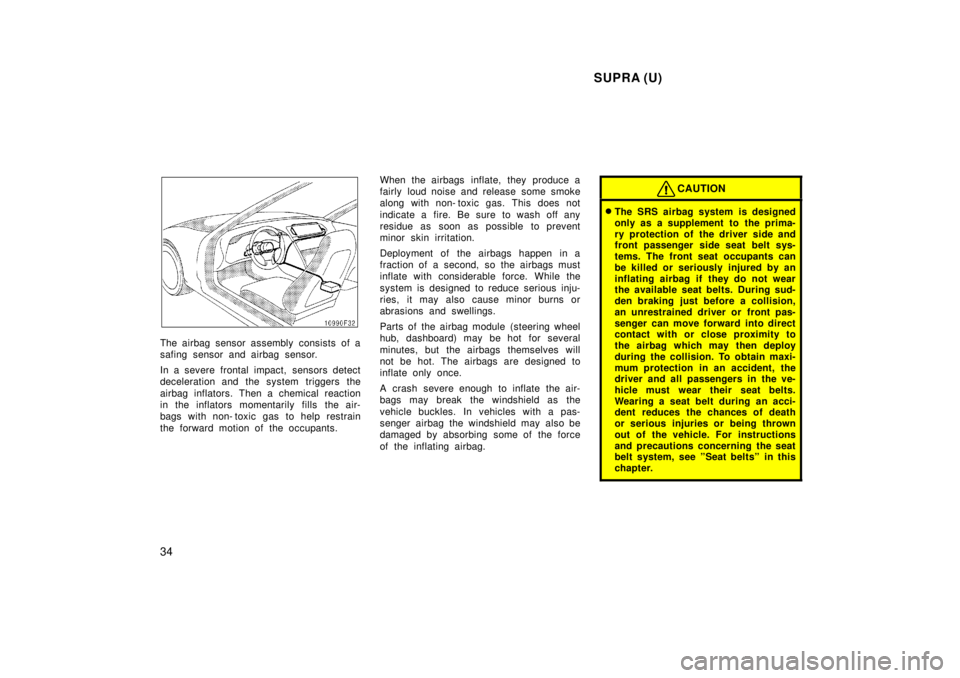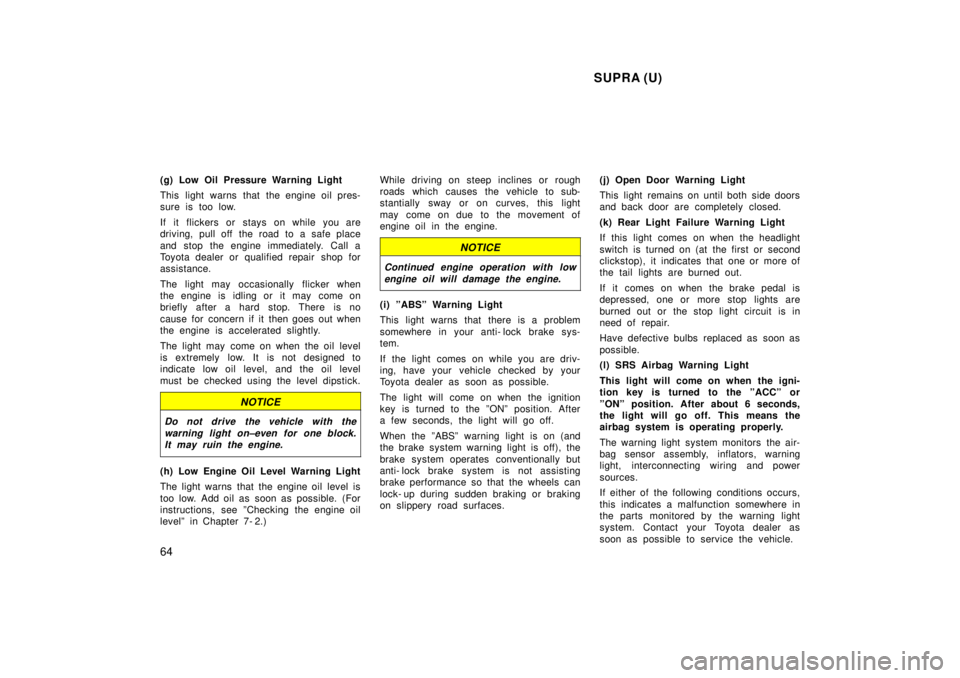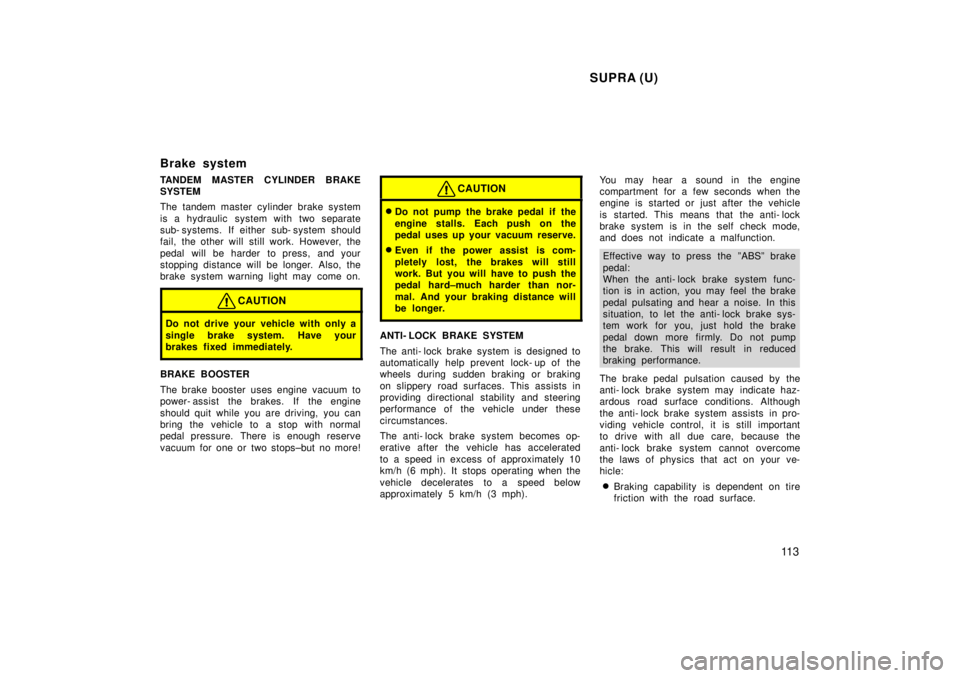1998 TOYOTA SUPRA ABS
[x] Cancel search: ABSPage 34 of 191

SUPRA (U)
34
The airbag sensor assembly consists of a
safing sensor and airbag sensor.
In a severe frontal impact, sensors detect
deceleration and the system triggers the
airbag inflators. Then a chemical reaction
in the inflators momentarily fills the air-
bags with non- toxic gas to help restrain
the forward motion of the occupants. When the airbags inflate, they produce a
fairly loud noise and release some smoke
along with non- toxic gas. This does not
indicate a fire. Be sure to wash off any
residue as soon as possible to prevent
minor skin irritation.
Deployment of the airbags happen in a
fraction of a second, so the airbags must
inflate with considerable force. While the
system is desi
gned to reduce serious inju-
ries, it may also cause minor burns or
abrasions and swellings.
Parts of the airbag module (steering wheel
hub, dashboard) may be hot for several
minutes, but the airbags themselves will
not be hot. The airbags are designed to
inflate only once.
A crash severe enough to inflate the air-
bags may break the windshield as the
vehicle buckles. In vehicles with a pas-
senger airbag the windshield may also be
damaged by absorbing some of the force
of the inflating airbag.
CAUTION
� The SRS airbag system is designed
only as a supplement to the prima-
ry protection of the driver side and
front passenger side seat belt sys-
tems. The front seat occupants can
be killed or seriously injured by an
inflating airbag if they do not wear
the available seat belts. During sud-
den braking just before a collision,
an unrestrained driver or front pas-
senger can move forward into direct
contact with or close proximity to
the airbag which may then deploy
during the collision. To obtain maxi-
mum protection in an accident, the
driver and all passengers in the ve-
hicle must wear their seat belts.
Wearing a seat belt during an acci-
dent reduces the chances of death
or serious injuries or being thrown
out of the vehicle. For instructions
and precautions concerning the seat
belt system, see ºSeat beltsº in this
chapter.
Page 64 of 191

SUPRA (U)
64
(g) Low Oil Pressure Warning Light
This light warns that the engine oil pres-
sure is too low.
If it flickers or stays on while you are
driving, pull off the road to a safe place
and stop the engine immediately. Call a
Toyota dealer or qualified repair shop for
assistance.
The light may occasionally flicker when
the engine is idling or it may come on
briefly after a hard stop. There is no
cause for concern if it then goes out when
the engine is accelerated slightly.
The light may come on when the oil level
is extremely low. It is not designed to
indicate low oil level, and the oil level
must be checked using the level dipstick.
NOTICE
Do not drive the vehicle with the
warning light on±even for one block.It may ruin the engine.
(h) Low Engine Oil Level Warning Light
The light warns that the engine oil level is
too low. Add oil as soon as possible. (For
instructions, see ºChecking the engine oil
levelº in Chapter 7- 2.) While driving on steep inclines or rough
roads which causes the vehicle to sub-
stantially sway or on curves, this light
may come on due to the movement of
engine oil in the engine.
NOTICE
Continued engine operation with low
engine oil will damage the engine.
(i) ºABSº Warning Light
This light warns that there is a problem
somewhere in your anti- lock brake sys-
tem.
If the light comes on while you are driv-
ing, have your vehicle checked by your
Toyota dealer as soon as possible.
The light will come on when the ignition
key is turned to the ºONº position. After
a few seconds, the light will go off.
When the ºABSº warning light is on (and
the brake system warning light is off), the
brake system operates conventionally but
anti- lock brake system is not assisting
brake performance so that the wheels can
lock- up during sudden braking or braking
on slippery road surfaces. (j) Open Door Warning Light
This light remains on until both side doors
and back door are completely closed.
(k) Rear Light Failure Warning Light
If this light comes on when the headlight
switch is turned on (at the first or second
clickstop), it indicates that one or more of
the tail lights are burned out.
If it comes on when the brake pedal is
depressed, one or more stop lights are
burned out or the stop light circuit is in
need of repair.
Have defective bulbs replaced as soon as
possible.
(l) SRS Airbag Warning Light
This light will come on when the igni-
tion key is turned to the ºACCº or
ºONº position. After about 6 seconds,
the light will go off. This means the
airbag system is operating properly.
The warning light system monitors the air-
bag sensor assembly, inflators, warning
light, interconnecting wiring and power
sources.
If either of the following conditions occurs,
this indicates a malfunction somewhere in
the parts monitored by the warning light
system. Contact your Toyota dealer as
soon as possible to service the vehicle.
Page 65 of 191

SUPRA (U)65
�
The light does not come on when the
ignition key is turned to the ºACCº or
ºONº position or remains on.
� The light comes on while driving.
(m) ºTRAC OFFº Indicator/Warning
Light
This light comes on when the ignition key
is turned to ºONº, and will go off after 3
seconds. This means that the system is
operating properly.
If one of the following conditions occurs,
this indicates a malfunction somewhere in
the parts monitored by the warning light
system. Contact your Toyota dealer as
soon as possible to service the vehicle.
� The light remains on more than 3 se-
conds after the ignition switch is turnedon.
� The light comes on while driving even
if the ºTRAC OFFº switch is not
pushed.
� The light flashes.
(n) Key Reminder Buzzer
This buzzer reminds you to remove the
key when you open the driver 's door with
the ignition key in the ºACCº or ºLOCKº
position. CHECKING SERVICE REMINDER INDICA-
TORS (except the low fuel level warning
light)
1. Apply the parking brake.
2. Open one of the side doors or the back door.
The open door warning light should
come on.
3. Close the side door. The open door warning light should go
off.
4. Turn the ignition key to ºACCº. The SRS airbag warning light should
come on. It goes off after about 6 se-
conds.
5. Turn the ignition key to ºONº, but do not start the engine.
All the service reminder indicators except
the open door warning light and SRS air-
bag warning light should come on. The
ºABSº warning light goes off after about 3
seconds.
If any service reminder indicator or warn-
ing buzzer does not function as described
above, either the bulb is burned out or the
circuit is in need of repair. Have it
checked by your Toyota dealer as soon as
possible.
Page 113 of 191

SUPRA (U)11 3
Brake system
TANDEM MASTER CYLINDER BRAKE SYSTEM
The tandem master cylinder brake system
is a hydraulic system with two separate
sub- systems. If either sub- system s
hould
fail, the other will still work. However, the
pedal will be harder to press, and your
stopping distance will be longer. Also, the
brake system warning light may come on.
CAUTION
Do not drive your vehicle with only a
single brake system. Have your
brakes fixed immediately.
BRAKE BOOSTER
The brake booster uses engine vacuum to
power- assist the brakes. If the engine
should quit while you are driving, you can
bring the vehicle to a stop with normal
pedal pressure. There is enough reserve
vacuum for one or two stops±but no more!
CAUTION
� Do not pump the brake pedal if the
engine stalls. Each push on the
pedal uses up your vacuum reserve.
� Even if the power assist is com-
pletely lost, the brakes will still
work. But you will have to push the
pedal hard±much harder than nor-
mal. And your braking distance will
be longer.
ANTI- LOCK BRAKE SYSTEM
The anti- lock brake system is designed to
automatically help prevent lock- up of the
wheels during sudden braking or braking
on slippery road surfaces. This assists in
providing directional stab ility and steering
performance of the vehicle under these
circumstances.
The anti- lock brake system becomes op-
erative after the vehicle has accelerated
to a speed in excess of approximately 10
km/h (6 mph). It stops operating when the
vehicle decelerates to a speed below
approximately 5 km/h (3 mph). You may hear a sound in the engine
compartment for a few seconds when the
engine is started or just after the vehicle
is started. This means that the anti- lock
brake system is in the self check mode,
and does not indicate a malfunction.
Effective way to press the ºABSº brake
pedal:
When the anti- lock brake system func-
tion is in action, you may feel the brake
pedal pulsating and hear a noise. In this
situation, to let the anti- lock brake sys-
tem work for you, just hold the brake
pedal down more firmly. Do not pump
the brake. This will result in reduced
braking performance.
The brake pedal pulsation caused by the
anti- lock brake system may indicate haz-
ardous road surface conditions. Although
the anti- lock brake system assists in pro-
viding vehicle control, it is still important
to drive with all due care, because the
anti- lock brake system cannot overcome
the laws of physics that act on your ve-
hicle: � Braking capab ility is dependent on tire
friction with the road surface.
Page 114 of 191

SUPRA (U)
11 4 �
Even though the anti- lock brake sys-
tem is operating, a driver cannot main-
tain full control on certain slippery road
surfaces, when cornering at high
speeds, or in violent maneuvers.
� Avoid high speeds on wet roads. The
anti- lock brake system cannot elimi-
nate the risk of hydroplaning and loss
of tire friction.
Always maintain a safe distance from the
vehicle in front of you. Compared with
vehicles not fitted with an anti- lock brake
system, your vehicle may r equire a longer
stopping distance in the following cases:
� Driving on rough, gravel or snow- cov-
ered roads.
� Driving with tire chains installed.
� Driving on roads where the road sur-
face is pitted or has other differences
in surface height.
ºABSº warning light
This light comes on when the ignition key
is turned to the ºONº position. After a few
seconds, the light will go off.
If either of the following conditions occurs,
this indicates a malfunction somewhere in
the parts monitored by the warning light
system. Contact your Toyota dealer as
soon as possible to service the vehicle.
� The light does not come on as de-
scribed above, or remains on.
� The light comes on while driving. Even if the anti- lock brake system should
fail, the brake system will still operate
conventionally. However, when the ºABSº
warning light is on (and the brake system
warning light is off), the anti- lock brake
system is not assisting brake performance
so that the wheels can lock- up during
sudden braking or braking on slippery
road surfaces. Have your vehicle checked
by your Toyota dealer as soon as pos-
sible.
DRUM- IN- DISC TYPE PARKING BRAKE SYSTEM
Your vehicle has a drum- in- disc type
parking brake system. This type of brake
system n
eeds bedding- down of the brake
shoes periodically or whenever the parking
brake shoes and/or drums are replaced.
Have your Toyota dealer perform the bed-
ding- down.
Page 163 of 191

SUPRA (U)
164
Checking brake fluid
60220F04
To check the fluid level, simply look at
the see- through reservoir. The level
should be between the ºMAXº and
ºMINº lines on the reservoir.
It is normal for the brake fluid level to go
down slightly as the brake pads wear. So
be sure to keep the reservoir filled.
If the reservoir needs frequent ref illing, it
may indicate a serious mechanical prob-
lem.
If the level is low, add SAE J1703 or
FMVSS No.116 DOT 3 brake fluid to the
brake reservoir. Remove and replace the reservoir cover
by hand. Fill the brake fluid to the dotted
line. This brings the fluid to the correct
level when you put the cover back on.
Use only newly opened brake fluid. Once
opened, brake fluid absorbs moisture from
the air, and excess moisture can cause a
dangerous loss of braking.
CAUTION
Take care when filling the r
eservoir
because brake fluid can harm your
eyes and damage painted surfaces. If
fluid gets in your eyes, flush your
eyes with clean water.
NOTICE
If you spill the fluid, be sure to wash
it off with water to prevent it fromdamaging the parts or paint.
Checking power steering fluid
60240F08
Check the fluid level on the dipstick. If
necessary, add automatic transmission
fluid DEXRON �II or III.
If the vehicle has been driven around 80
km/h (50 mph) for 20 minutes (a little
more in frigid temperatures), the fluid is
hot (60 �CÐ80 �C or 140 �FÐ175 �F). You
may also check the level when the fluid
is cold (about room temperature,10 �CÐ30 �C or 50 �FÐ85 �F) if the engine
has not been run for about five hours.
a. Clean all dirt from outside of the reser-
voir tank.
b. Remove the filler cap by turning it
counterclockwise and wipe the dipstick
clean.
Page 189 of 191

SUPRA (U)
190
24. CIG 15 A:
Cigarette lighter, air condi-
tioning system, SRS airbag system,
theft deterrent system, shift lock con-
trol system
25. RAD NO.2 7.5 A: Radio, cassette tape
player, power antenna
26. TAIL 10 A: Tail lights, parking lights,
front side marker lights, rear side
marker lights, licence plate lights
27. ECU- IG 10 A: Cruise control system,
anti- lock brake system, power steering,
power antenna, theft deterrent system,
shift lock control system, traction con-
trol system
28. GAUGE 10 A: Gauges and meters, ser-
vice reminder indicators and warning
buzzers (except discharge and open
door warning lights), rear window de-
fogger, charging system, cruise control
system, electronically controlled auto-
matic transmission system, traction
control system
29. ECU- B 10 A: Air conditioning system,
cruise control system, anti- lock brake
system, SRS airbag system, traction
control system
30. OBD - II 7.5A: On- board diagnosis sys-
tem Fuses (type B)
31. DOOR 30 A: Power window, power
door lock system, theft deterrent sys-
tem
32. DEFOG 30 A: Rear window defogger
Fuses (type C)
33. ALT 120 A: Charging system
34. MAIN 50 A: Starter system, headlights
35. HTR 50 A: Air conditioning system
36. FAN 30 A: Electric cooling fans
37. ABS NO.1 60 A: Anti- lock brake sys-
tem, traction control system
38. AM1 50 A: Electronic ignition system/
distributor ignition system
39. POWER 60 A: ºPANELº, ºSTOPº,
ºTAILº, ºECU- Bº, ºDEFOGº and
ºDOORº fuses